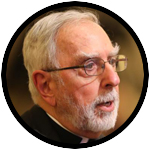
Bishop Gerald F. Kicanas, retired bishop of Tucson, Arizona.
In this guest commentary for Catholic News Service, retired Bishop Gerald F. Kicanas of Tucson, Arizona, says there is “much to celebrate” about the nation’s Catholic schools during National Catholic Schools Week. The bishop is chairman of the board of the National Catholic Educational Association and a member of the U.S. Conference of Catholic Bishops’ Committee on Catholic Education.
***
National Catholic Schools Week (Jan. 28-Feb. 3) highlights the significant contribution of the 6,300 Catholic schools that serve 1.8 million students and their families and communities. This week gives us much to celebrate and provides an opportunity to advocate for greater government support to make it possible for more parents to choose the best school for their child.
We celebrate the diversity of students served by our Catholic schools. Since St. Elizabeth Ann Seton opened the first parochial school for girls in Emmitsburg, Maryland in 1810, Catholic schools have proudly and intentionally served the neediest and most ethnically diverse populations. Catholic schools look like America; they serve children from all segments of society. Our doors are open to the poor, the immigrants and families of all faiths and beliefs. Nationwide, 20.8 percent of the students are racial minorities — 17.4 percent are Hispanic/Latino — and 19 percent are non-Catholic.
[hotblock]
We celebrate proven academic excellence in an environment where all students are challenged to excel. Catholic school students have a 99 percent on-time graduation rate. Eighty-four percent attend four-year colleges and others continue their studies at community or technical colleges. Poorer and more at-risk students show the greatest achievement gains. Latino and African-American students in Catholic schools are more likely to graduate from high school and college than their peers in public schools. Students with multiple disadvantages benefit most from Catholic schools.
We celebrate the contribution of Catholic schools to society. Take the cost of education. In Catholic schools, the elementary mean cost (per pupil) is $5,936 and secondary is $15,249. This is significantly below public school costs. Look at the results of a Catholic school education. Research demonstrates that our graduates are more likely to vote, be more civically engaged, be more tolerant of diverse views, less likely to be incarcerated and are more committed to service as adults. Graduates also enjoy higher earning potential.
We celebrate the centrality of faith in our Catholic schools. Catholicism gives shape to the climate and culture present within the walls of our schools. We teach faith. We model faith. We foster faith. Many parents want their children to be in a school environment that forms values and fosters ethical living. They should have that choice.
As we celebrate this week, we also raise the need for expanded state and federal support to ensure parents’ right to choose the best school for their child. Much progress has been made across the country at the state level. At the federal level, there is now a new option provided by the 2017 Tax Cut and Jobs Act that offers parents the opportunity to save for their child’s education. The popular 529 Savings Accounts, which more than 13 million families use to save for higher education, may now be used for tuition expenses in grades K-12. While this provision is a significant step, more needs to be done.
[hotblock2]
To ensure access to school choice for all children, particularly those of low and modest incomes, and in keeping with President Donald Trump’s campaign promise, Congress should write a national education tax credit plan to create scholarship granting entities (SGOs) in every state. These organizations would raise funds from private donors and businesses using the benefit of a federal tax credit without taking any money out of the federal or state education budgets. The funding source would be a new stream of private money, stimulated by the federal tax break. Parental choice is just an idea if there is not funding to enact real change in the lives of students.
Especially this week: Celebrate, get involved and advocate on behalf of Catholic schools that matter and make such a difference in our society.
***
Editor’s Note: More details on the research, statistics and church documents referenced in this guest commentary can be found at www.usccb.org and ncea.org.
PREVIOUS: Are we empowering women, or the men who patronize them?
NEXT: Put the needle down: City must drop plan for safe injection sites



Share this story